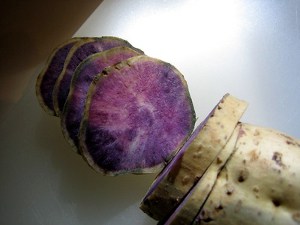
Today, I’m going to be looking at one of the most incredible vegetables that I have ever seen.
Straight from the off I need to tell you that I have never seen an ube or a purple yam as they are also known as.
But the shade of deep purple that they turn when they have been cooked is dazzling.
There is no other word for it.
The beautiful dark orange of a sweet potato always transforms any plate of food but an ube is something else.
It is funny that I have got a little distracted and focused on how an ube looks as I will be thinking about how safe they are for dogs to eat.
And most dogs, as we know, care little for how their food looks!
Can dogs eat ube?
Having looked at lots of different pieces of information, you will be pleased to hear that your dog can safely eat ube.
Just make sure that the ube is cooked- steamed or boiled is the best approach and that your dog only eats a small amount of it.
Which is the same advice that I would give for a sweet potato or a yam come to think of it.
Fresh ubes are quite hard to get hold off in the US and UK and so some people use an ube extract, which is a powder in a jar.
A slight issue is that this extract might contain a substance which at very high levels is toxic to dogs.
But I will discuss that in more detail later.
First of all, let’s go back to basics.
[1] What is ube?
Ubes (pronounced oo-bey) is a purple coloured yam which has been a staple ingredient in lots of deserts in the Philippines.
Yes it really is that sweet.
In recent years it has become more popular in the US and a lot of its popularity comes from the fact that it has an awesome colour.
Ubes have a white skin and a light purple flesh, which darkens when it is cooked and makes any dish look absolutely stunning.
In the US you are most likely to find an ube used in ice creams whereas in the Philippines it is more widely used to make sweet jams.
[2] What is the difference between ube, yams, sweet potato and taro?
You might well know that many people think that sweet potatoes are a type of yam but these people are wrong.
They are two separate species of plants and they are very different in a few important ways.
Yams are far, far bigger than sweet potatoes and their skin is a lot tougher and it is very hard to peel.
Taste wise, yams are much less sweet than sweet potatoes, with a starchy and dryer texture.
The other thing is that yams are much, much harder to get hold of in the US or the UK because most of them are grown in Africa.
Ubes can be mistaken for red yams.
An ube is a type of yam.
They are both narrower and more cylindrical to a sweet potato’s more tubular shape. But, whereas an ube’s skin is off white the skin of a red yam is burgundy.
An ube has purple flesh compared to the orange flesh of a red yam.
And where does taro fit into all of this confusing mix.
Well taro isn’t a yam or a sweet potato.
But it is a root vegetable.
And it can be purple- although not the dark purple of an ube but more of a lavender.
A taro has a less sweet taster than an ube.
[3] Are ubes toxic to dogs?
No, ubes aren’t toxic for dogs.
They don’t contain any minerals or chemical compounds which will in any way threaten your dog’s well being.
But there are a few things to bear in mind.
The AKC recommends that you don’t feed sweet potatoes or yams to your dog raw as it might cause them to have a little stomach upset or if they don’t chew it properly before they eat it, it might choke them.
And so I would put an ube in the same category- if you are going to feed it to your dog cook it first.
But I think that there is another important consideration when it comes to feeding an ube to your dog.
And that is that they aren’t widely available in either the UK or US.
They aren’t something that you will find in Walmart or Kroger.
You will need to hunt for them in your local Asian supermarket.
And so with all of that extra effort and cost (I would imagine) are these a vegetable that you seriously want to feed to your dog?
But if you are determined to feed them to your dog every now and again, let’s find out how nutritious they are.
What is the nutrition of an ube?
To help you and me with this, I am going to add a comparison chart that shows the nutrition of an ube and a sweet potato.
After all, most of us are used to sweet potatoes.
In terms of sources, the full nutrition data for a purple yam can be found here.
And for a sweet potato- it is here.
| 100 g serving | Ube | Sweet Potato |
| Calories | 140 | 109 |
| Fat | .1 g | 4.3 g |
| Carbohydrates | 27 g | 17 g |
| Sugar | 0 g | 5.5 g |
| Dietary Fibre | 4 g | 2.4 g |
| Protein | 1 g | 1.3 g |
That is quite shocking to me.
Having read that purple yams are widely used in desserts because they are so sweet but when we look at the nutrition data, an ube actually has 0 grams of sugar in it, whereas a sweet potato has over 5 grams of sugar.
An ube has lots more calories in them as well as far more carbohydrates than sweet potato but they also have significantly more dietary fibre in them.
This might be good news for those of you who are looking for a natural and high fibre cure for dog diarrhea!
Let’s do a quick check on the main vitamins and minerals within these two vegetables
| Ube | Sweet Potato | |
| Sodium | 10 mg | 189 mg |
| Calcium | 20 mg | 37 mg |
| Iron | .36 mg | .95 mg |
| Vitamin A | 100 IU | 888 mg |
| Vitamin C | 12 mg | 18.4 mg |
Sweet potato offers your dog a more powerful vitamin and mineral boost than an ube does.
It will provide your dog with more calcium, iron, vitamin A and C.
But, and this is a big but…
What really stands out is that an ube is so low in sodium, whereas the levels of sodium in a sweet potato are through the roof!
So, how much ube should you feed to your dog?
[6] How much ube should you feed your dog?
I would be tempted to be a little sarcastic here and refer back to the fact that purple yams for many of us are hard to come by.
And so, in answer to the question of how much? I would say as much as you can afford to give them.
The dose that you decide to give to your dog really depends on how big your dog is.
I’m making a presumption here that you have never fed your dog any purple yam before.
As with any other food that you are introducing to your dog, regardless of size, start off with small amounts and increase the portion size slowly.
This softly, softly approach will give your dog a chance to become familiar with the food.
After your dog has shown that “it’s stomach likes the taste of ube”, you can go crazy and feed them as much as you want!
No- I’m only joking.
Even the biggest dogs should only have a few tablespoons of ube added to their food every so often.
And for much smaller breeds of dogs, you should be looking at a maximum of one tablespoon.
And remember don’t and add it to your dog’s diet everyday.
There is nothing wrong with adding vegetables to your dog’s food everyday as long as you are adding moderate amounts and as long as you vary the type of vegetables that you add into your dog’s diet…
And talking of variety, in the next section I will be looking at all the different foods that you and your dog might come across that contain ube.
[4] What can you make with an ube?
It seems to me that if you are in the US, there are two foods that are most likely to have ube in them- ice cream and bread rolls (pandesals.)
The first thing that I want to say is that having already established that an ube won’t harm your dog, the other ingredients in the ice cream or bread pose more of a risk to your dog.
It isn’t that ice cream or bread contain any toxic ingredients- it is just that none of the ingredients can be considered healthy.
I mean typical ingredients for ice cream include cream, milk with a little sugar or vanilla to help the flavouring.
And with bread there is flour and a little salt and sugar.
As I said- these ingredients don’t kill.
Ube extract is toxic to your dog
As I said, these ingredients don’t kill unless your ice cream or bread rolls were made with ube extract and not real ubes.
Earlier I spoke about how difficult it was to buy ubes in most grocery stores.
Well in order to plug this gap in the market, people can buy ube extract.
Which gives the same vibrant colour of an ube without the hassle of trying to locate a fresh one and peel it.
Not bad eh?
But as well as containing ube, some ube extracts (two that I looked at on Amazon) contain a chemical that is toxic to dogs- named propylene glycol.
Not to be confused with ethylene glycol which is incredibly dangerous to dogs.
Most commonly found in antifreeze, ethylene glycol might kill a dog after only a few licks.
Propylene glycol is much safer and is only toxic to dogs if they consume large amounts- which they probably won’t with the odd bite of ube ice cream or ube bread…
But, it is something to be aware of.






